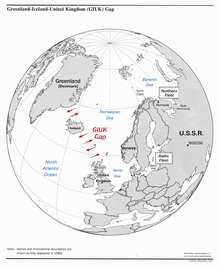| Exercise Strikeback | |
|---|---|
| Part of Cold War (1953–1962) | |
 The "GIUK Gap" | |
| Type | NATO multi-lateral naval training exercise |
| Location | |
| Planned by | Supreme Allied Commander Atlantic |
| Objective | Deployment of NATO anti-submarine warfare and aircraft carrier strike forces |
| Date | 3–12 September 1957 |
| Executed by | Vice Admiral Robert B. Pirie, USN, Commander Striking Fleet Atlantic (STRIKFLTLANT) |
| Outcome | Exercise successfully executed. |
Exercise Strikeback aka Operation Strikeback was a major naval exercise of the North Atlantic Treaty Organization (NATO) that took place over a ten-day period in September 1957.
As part of a series of exercises to simulate an all-out Soviet attack on NATO, Exercise Strikeback was tasked with two objectives. Its initial objective was the deployment of NATO's naval forces (designated the "Blue Fleet") against other NATO forces attempting to simulate an "enemy" navy that featured a large number of submarines (designated the "Orange Fleet"). Its other objective was to have the Blue Fleet execute carrier-based air strikes against "enemy" formations and emplacements along NATO's northern flank in Norway.
Exercise Strikeback involved over 200 warships, 650 aircraft, and 75,000 personnel from the United States Navy, the Royal Navy, the Royal Canadian Navy, the French Navy, the Royal Netherlands Navy, and the Royal Norwegian Navy. As the largest peacetime naval operation up to that time, military reporter Hanson W. Baldwin of The New York Times said Exercise Strikeback gathered "the strongest striking fleet assembled since World War II."[1]
Strikeback and the other concurrent NATO exercises held during the fall of 1957 would be the most ambitious military undertaking for the alliance to date, involving more than 250,000 men, 300 ships, and 1,500 aircraft operating from Norway to Turkey.[2][3]
- ^ Baldwin, Hanson W. (22 September 1957). "100 Fighting Ships in Vast Exercise". The New York Times. Retrieved 28 September 2009.
- ^ Key Jr., David M. (2001). Admiral Jerauld Wright: Warrior among Diplomats. Manhattan, Kansas: Sunflower University Press. p. 333. ISBN 978-0-89745-251-9.
- ^ "Emergency Call". Time. 30 September 1957. Archived from the original on 28 June 2011. Retrieved 3 October 2008.